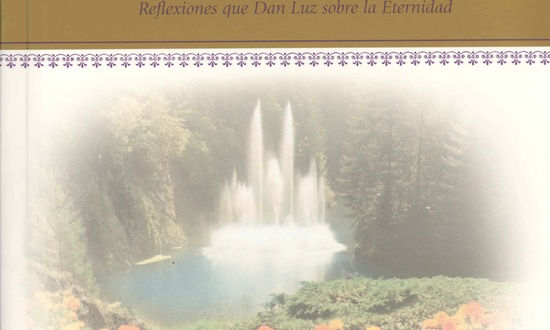[Los siervos de Dios] lo verán cara a cara. —Apocalipsis 22:4
Me levantaré de los muertos. . . . Veré al Hijo de Dios, el Sol de Gloria, y brillaré como brilla el sol. Seré unido al Anciano de Días, a Dios mismo, para quien el tiempo no existe, nunca comenzó. . . . Ningún hombre jamás vio a Dios y vivió. Y sin embargo, yo no viviré hasta que vea a Dios; y cuando lo haya visto, nunca moriré. —John Donne
Nuestro anhelo del Cielo es nuestro anhelo por Dios, un anhelo que involucra no sólo a nuestro ser interior sino también a nuestro cuerpo. Estar con Dios es el corazón y el alma del Cielo. Todos los otros placeres celestiales derivarán de y serán secundarios a su santa presencia. El don más grande de Dios es, y siempre será, sí mismo. Su presencia trae satisfacción. Su ausencia trae sed y añoranza.
“Cual ciervo jadeante en busca del agua, así te busca, oh Dios, todo mi ser. Tengo sed de Dios, del Dios de la vida. ¿Cuándo podré presentarme ante Dios?” (Salmo 42:1-2).
“Oh Dios, tú eres mi Dios; yo te busco intensamente. Mi alma tiene sed de ti; todo mi ser te anhela, cual tierra seca, extenuada y sedienta” (Salmo 63:1).
Los teólogos de la antigüedad a menudo hablaban de la “visión beatífi ca.” Este término viene de tres palabras del latín que juntas signifi can “una visión que hace feliz.” La visión de que hablaban era Dios. La mayor aspiración es ver el rostro de Dios. Es triste, entonces, que para la mayoría de nosotros no se encuentra en la parte superior de nuestra lista de deseos.
Cuando Moisés le dijo a Dios: “Déjame verte en todo tu esplendor,” Dios le respondió: “Voy a darte pruebas de mi bondad. . . . Pero debo aclararte que no podrás ver mi rostro, porque nadie puede verme y seguir con vida. . . . Cuando yo pase en todo mi esplendor, te pondré en una hendidura de la roca y te cubriré con mi mano, hasta que haya pasado. Luego, retiraré la mano y podrás verme la espalda. Pero mi rostro no lo verás” (Éxodo 33:18-23).
Moisés vio a Dios, pero no vio el rostro de Dios. El Nuevo Testamento dice que Dios “vive en luz inaccesible, a quien nadie ha visto ni puede ver” (1 Timoteo 6:16). Por eso, deberíamos estar asombrados cuando en Apocalipsis 22:4 se nos dice que veremos el rostro de Dios.
“Busquen . . . la santidad, sin la cual nadie verá al Señor” (Hebreos 12:14). Los obstáculos para ver a Dios intimidan. Es sólo porque seremos completamente justos y sin pecado que podremos ver a Dios y vivir. Ver a Dios será nuestro mayor gozo, el gozo por el cual se medirán todos los demás gozos.
David dice: “Una sola cosa le pido al Señor, y es lo único que Cuando veamos el rostro de Dios 15 persigo: habitar en la casa del Señor todos los días de mi vida, para contemplar la hermosura del Señor y recrearme en su templo” (Salmo 27:4). David estaba preocupado por la persona de Dios, y también por el lugar donde estaba Dios. Él anhelaba estar donde estaba Dios y contemplar su hermosura. Ver el rostro de Dios es contemplar su hermosura.
Cuando Jesucristo vino a la Tierra como uno de nosotros ( Juan 1:14), Dios, quien es trascendente, se hizo inmanente. Por eso es que uno de los nombres que se le dio a Jesús es Emanuel, “Dios con nosotros” (Mateo 1:23). Debido a que Dios el Padre y Dios el Hijo son uno ( Juan 10:30), cada vez que veamos a Jesús en el Cielo, veremos a Dios. Puesto que Jesucristo es una manifestación permanente de Dios, le pudo decir a Felipe, uno de sus discípulos: “El que me ha visto a mí, ha visto al Padre” ( Juan 14:9). Por cierto, entonces, que una manera principal en que veremos a Dios el Padre en la Nueva Tierra será a través de su Hijo, Jesús.
Jesús también dice: “Dichosos los de corazón limpio, porque ellos verán a Dios” (Mateo 5:8). En Apocalipsis 22:4, cuando dice que “lo verán cara a cara, y llevarán su nombre en la frente,” parece estar refi riéndose a ver la cara de Dios el Padre.
Dios, quien no es inherentemente físico, ¿tiene un rostro en algún sentido que no sea fi gurado? No estoy seguro. Y no pretendo entender cómo veremos su rostro. Pero me gozo en la anticipación de que lo veremos.
La Biblia está llena de grandes promesas de lo que nos espera en el Cielo. Sin embargo, ninguna es más grande que la promesa de que, como seres humanos resucitados, realmente veremos a Dios.
Si usted es seguidor de Jesús, ¿qué le gustaría decirle un día a Dios, a quien un día verá?
Padre, llénanos de la maravilla de poder verte cara a cara, caminar al lado de tu Hijo y contemplar su rostro eternamente humano y divino. Qué delicia será verte a ti, la fuente de todo bien, toda belleza y todo misterio. Y qué experiencia incomparable será no sólo imaginarnos, sino un día ver realmente tu rostro —verte a ti, quien formó las galaxias, quien le dio forma a la Tierra y a sus animales, océanos, bosques y flores, quien nos creó a nosotros según tu gloriosa imagen. Que jamás perdamos de vista nuestra meta principal, que es verte a ti. Y que podamos impartir esa visión a los que nos rodean, incluyendo a nuestros hijos y nietos.
Extracto de 50 Días del Cielo by Randy Alcorn, Día 3.
Seeing God’s Face (Excerpt from 50 Days of Heaven)
[God’s servants] will see his face. — Revelation 22:4
I shall rise from the dead. . . . I shall see the Son of God, the Sun of Glory, and shine myself as that sun shines. I shall be united to the Ancient of Days, to God Himself, who had no morning, never began. . . . No man ever saw God and lived. And yet, I shall not live till I see God; and when I have seen him, I shall never die. — John Donne [1]
Our longing for Heaven is a longing for God—a longing that involves not only our inner selves but our bodies as well. Being with God is the heart and soul of Heaven. Every other heavenly pleasure will derive from and be secondary to his holy presence. God’s greatest gift to us is, and always will be, himself. His presence brings satisfaction. His absence brings thirst and longing.
“As the deer pants for streams of water, so my soul pants for you, O God. My soul thirsts for God, for the living God. When can I go and meet with God?” (Psalm 42:1-2).
“O God, you are my God, earnestly I seek you; my soul thirsts for you, my body longs for you, in a dry and weary land where there is no water” (Psalm 63:1).
Ancient theologians often spoke of the “beatific vision.” The term comes from three Latin words that together mean “a happy-making sight.” The sight they spoke of was God. To see God’s face is the loftiest of all aspirations. It’s sad, then, that for most of us, it’s not at the top of our list of desires.
When Moses said to God, “Show me your glory,” God responded, “I will cause all my goodness to pass in front of you. . . . [But] you cannot see my face, for no one may see me and live. . . . When my glory passes by, I will put you in a cleft in the rock and cover you with my hand until I have passed by. Then I will remove my hand and you will see my back; but my face must not be seen” (Exodus 33:18-23).
Moses saw God, but not God’s face. The New Testament says that God “lives in unapproachable light, whom no one has seen or can see” (1 Timothy 6:16). Thus, when we’re told in Revelation 22:4 that we’ll see God’s face, it should astound us.
“Without holiness no one will see the Lord” (Hebrews 12:14). The obstacles to seeing God are daunting. It’s only because we’ll be fully righteous in Christ and completely sinless that we’ll be able to see God and live. To see God will be our greatest joy, the joy by which all other joys will be measured.
David says, “One thing I ask of the Lord, this is what I seek: that I may dwell in the house of the Lord all the days of my life, to gaze upon the beauty of the Lord and to seek him in his temple” (Psalm 27:4). David was preoccupied with God’s person, and also with God’s place. He longed to be where God was and to gaze on his beauty. To see God’s face is to behold his beauty.
When Jesus Christ came to Earth as one of us (John 1:14), God, who is transcendent, became immanent. Thus, one of the names given to Jesus is Immanuel, “God with us” (Matthew 1:23). Because God the Father and God the Son are one (John 10:30), whenever we see Jesus in Heaven, we will see God. Because Jesus Christ is a permanent manifestation of God, he could say to his disciple Philip, “Anyone who has seen me has seen the Father” (John 14:9). Certainly, then, a primary way that we will see God the Father on the New Earth is through his Son, Jesus.
Jesus also says, “Blessed are the pure in heart, for they will see God” (Matthew 5:8). In Revelation 22:4, when it says “they will see his face, and his name will be on their foreheads,” it appears to be referring to seeing the face of God the Father.
Does God, who is not inherently physical, have a face in any sense but a figurative one? I’m not certain. And I don’t pretend to understand how we will see his face. But I rejoice in the anticipation that we will!
Scripture is full of great promises about what awaits us in Heaven. However, none is greater than the promise that we, as resurrected human beings, will actually see God.
If you’re a follower of Jesus, what would you like to say now to the God whom you will one day see?
Father, fill us with the wonder of being able to see you face-to-face, to walk beside your Son and behold his eternally human and divine face. What a delight to gaze at you, the source of all good, all beauty, all mystery. And what an incomparable experience to not only imagine but one day actually see your face—you who spun the galaxies into existence, who wove together the earth with its animals and oceans and forests and flowers, who created us in your glorious image. May we never lose sight of our highest destiny, to see you. And may we pass on that vision to those around us, including our children and grandchildren.
Excerpt from 50 Days of Heaven by Randy Alcorn, Day 3.



